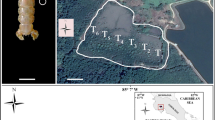Abstract
The ability of males of Littorina littorea and L. saxatilis to discriminate between mates of different sex, species and size was examined. In partner choice experiments males of L. littorea had the possibility to initiate a copulation with either a female or a male. The males did not show a preference for either sex. There was therefore no evidence that they could determine the sex of a conspecific prior to copulation. The duration of intrasexual copulation was considerably shorter than for intersexual copulation, both in the field and in laboratory experiments. For the two species, intersexual copulations were far more frequent than intrasexual ones. This can partly be explained by the difference in copulation time.
Few interspecific copulating pairs were found on the shore. This may reflect a low interspecific encounter rate rather than a mechanism of species recognition. On all of these occasions, however, the active male was of L. saxatilis. It is argued that selection against precopulatory species and sex recognition is a more likely explanation than an hypothesis that states that the required mutations for precopulatory mate identification has not yet occurred.
L. littorea males copulated longer with large than with small females. Copulation time was short with parasitized females, which are sterile or of low fecundity. The allocation of mating effort by males is discussed.
Similar content being viewed by others
References
Abele, L. G. & S. Gilchrist, 1977. Homosexual rape in acanthocephalan worms. Science 197: 81–83.
Buckland-Nicks, J. A. & F. S. Chia, 1977. On the nurse cell and the spermatozeugma in Littorina sitkana. Cell and Tissue Research 179: 347–356.
Cate, J. M., 1968. Mating behavior in Mitria idae Melvill, 1893. Veliger 10: 247–252.
Connor, V. M., 1986. The use of mucous trails by intertidal limpets to enhance food resources. Biol. Bull. 171: 548–564.
Croll, R. P., 1983. Gastropod chemoreception. Biol. Rev. 58: 293–319.
Daly, M., 1978. The cost of mating. Am. Nat. 112: 771–774.
Dewsbury, D. A., 1982. Ejaculate cost and male choice. Am. Nat. 119: 601–610.
Dinter, I. & P. J. Manos, 1972. Evidence for a pheromone in the marine periwinkle Littorina littorea Linnaeus. Veliger 15: 45–47.
Edwards, D. C., 1968. Reproduction in Oliviella biplicata. Veliger 10: 297–304.
Fretter, V. & A. Graham, 1962. British prosobranch molluscs. Ray Society, London, 755 pp.
Gibson, D. G., 1965. Mating behavior in Littorina planaxis Philippi (Gastropoda: Prosobranchiata). Veliger 7: 134–139.
Gwynne, D. T., 1981. Sexual difference theory: mormon crickets show role reversal in mate choice. Science 213: 779–780.
Hughes, R. N. & P. Answer, 1982. Growth, spawning and trematode infection of Littorina littorea (L.) from an exposed shore in north Wales. J. moll. Stud. 48: 321–330.
Janson, K., 1985. Variation in the occurence of abnormal embryos in females of the intertidal gastropod Littorina saxatifs Olivi J. moll. Stud. 51: 64–68.
Knowlton, N. & S. R. Greenwell, 1984. Male sperm competition avoidance mechanisms: The influence of female interests. In R. L. Smith (ed.), Sperm competition and the evolution of animal mating systems. Academic Press, Orlando (Florida): 62–83.
Martel, A., D. H. Larrivée, K. R. Klein & J. H. Himmelman, 1986. Reproductive cycle and seasonal feeding activity of the neogastropod Buccinum undatum. Mar. Biol. 92: 211–221.
Parker, G. A., 1978. Searching for mates. In J. R. Krebs & N. B. Davies (ed), Behavioural ecology an evolutionary approach. Blackwell Scientific Publications, Oxford: 214–244.
Peters, R. S., 1962. Function of the cephalic tentacles in Littorina Philippi (Gastropoda: Prosobranchiata). Veliger 7: 143–148.
Raffaelli, D. G., 1977. Observations of the copulatory behavior of Littorina rudis Maton and Littorina nigrolineata Gray (Gastropoda: Prosobranchia). Veliger 20: 75–77.
Rutowsky, R. L., 1982. Epigamic selection by males as evidenced by courtship partner preferences in the checkered white butterfly (Pieris protodice). Anim. Behav. 30: 108–112.
Schutz, F., 1966. Homosexualität bei Tieren. Studium Generale 19: 273–285.
Struhsaker, J. W., 1966. Breeding, spawning periodicity and early development in the Hawaiian Littorina: L. pintado (Wood), L. picta Philippi and L. scabra (Linné). Proc. malac. Soc. Lond. 37: 137–166.
Svärd, L. & C. Wiklund, 1986. Different delivery strategies in first versus subsequent mating in the swallowtail butterfly Papilio machaon L. Behav. Ecol. Sociobiol. 18: 325–330.
Verell, P. A., 1982. Male newts prefer large females as mates. Anim. Behav. 30: 1254–1255.
Wiklund, C. & J. Forsberg, 1985. Courtship and male discrimination between virgin and mated females in the orange tip butterfly Anthocharis cardamines. Anim. Behav. 34:328–332.
Author information
Authors and Affiliations
Rights and permissions
About this article
Cite this article
Saur, M. Mate discrimination in Littorina littorea (L.) and L. saxatilis (Olivi) (Mollusca:Prosobranchia). Hydrobiologia 193, 261–270 (1990). https://doi.org/10.1007/BF00028082
Issue Date:
DOI: https://doi.org/10.1007/BF00028082




